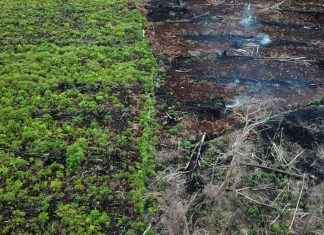Our net emissions of greenhouse gases must be down to zero by 2050 if we are to limit global warming to 1.5 degrees. In addition, between 100 and 1,000 billion tons of carbon dioxide removed from the atmosphere before the end of the century, according to the intergovernmental panel on climate change IPCC report, which came in October.
Link to the graphics
– Our carbon budget is close to exhausted. Soon we come to a point where all the carbon dioxide we emit must be caught in again. Therefore, we need negative emissions, ” says Anders Lyngfelt, professor of energy technology at the department of space, geo – and environmental sciences at the Chalmers technical university in Gothenburg, sweden.
in order to remove the carbon dioxide that we already have released. The simplest is to use that green plants take carbon dioxide from the air to produce nutrients and oxygen. We can plant more trees and forests, and we can bury the charcoal in the soil, to prevent the carbon dioxide that a tree once trapped in from the air coming out of the atmosphere again.
The technology that is discussed most is called bio-energy with carbon capture and storage, or BECCS (bio-energy with carbon capture and storage), where the carbon dioxide that the plants took up from the air stored in the bedrock. The idea is to grow trees or other plants and burn them in power plants or to produce biofuels from them, take care of the carbon dioxide that is formed and pump it down into the ground. Where it is stored in empty gas and oil fields or in the so-called saline aquifers, a kind of saltvattenmagasin in porous sandstone, down in the bedrock or under the seabed.
Link to the graphics
some experience of storing carbon dioxide in bedrock, including from oil and gas fields in Norway and in facilities in the united states. But for that the techniques will start to be used, it must be worthwhile financially.
” the fundamental problem is that fossil fuels are almost always the cheapest options, and the market choose the one that is the cheapest. You can see the market as an animal that makes it it is brought up to. Therefore, we need to make fossil fuels more expensive, ” says Anders Lyngfelt.
Those who emit carbon dioxide should only have to pay what it costs to capture it, is his solution. The cost is approximately sek 1,000 per tonne, or a penny per kilogram.
There are massive amounts of carbon dioxide that must be removed from the atmosphere in the IPCC scenarios. 800 billion tonnes of carbon dioxide equivalent to 100 tonnes per person living in the day.
” But if we cannot even manage to agree to reduce emissions now, how will we ever be able to hope that the world’s finance ministers in the future should agree about who should pay the enormous bill for negative emissions? There are of course 100,000 per living human being. I find it difficult to see how finance ministers will be able to put the cost in front of schools, health care and everything else the money needs to go to, ” says Anders Lyngfelt.
If we quickly introduce a preventive cleaning is going to bring down costs, he says, because it will be a lot cheaper not to emit carbon dioxide than to first release it and then pay to capture it.
Link to the graphics
on what technology can achieve. In a film that is spread on social media describing a canadian company how they can extract carbon dioxide directly from the air and transform into a fuel for use in today’s gasoline and diesel vehicles.
– in Addition to the major technical problems, there is a danger that policy-makers and the general public get the impression that we don’t need to act so quickly and frequently now to reduce emissions because such technology will organize everything, in the end, ” says Tobias Pröll, professor in energy technology at the university of natural resources and life sciences in Vienna.
the Energy required to capture carbon dioxide increases significantly in the more dilute it is
the Plant shown in the movie sucks in air and washing away of carbon dioxide by chemical reactions.
– the main problem is that the carbon dioxide in the air is very dilute, and the energy required to capture the substantial increase in the more dilute it is. It is a consequence of the second law of thermodynamics the second law of thermodynamics, i.e. basic physics, ” says Tobias Pröll.
that emits significantly more concentrated carbon dioxide, it is extremely much efficient to capture the carbon dioxide.
– To capture carbon dioxide directly from the air is of course technically possible, but it requires three or four times more energy and ten times as expensive to capture carbon dioxide in a stack. In addition, there are a lot of technical challenges, ” says Tobias Pröll.
To produce fuel of the carbon dioxide is also a bad idea, ” he says.
– Is it really worth all the costs and then releasing the carbon dioxide again?
Direktinfångning can only be relevant in a future with very high fees on emissions of carbon dioxide, in places far away from the chimneys, where there is a surplus of deneme bonusu free or very cheap renewable energy, and carbon dioxide can be stored safely, according to Tobias Pröll.
“It’s a great hype around the technology now, but as far as we know, there is no way to get past the basic laws of physics,” he says.
Trees are good at capturing carbon as long as the forest doesn’t burn or cutting. Photo: Rolf Carlsson
to have any effect, we must be able to trust that the carbon dioxide will not leak out into the atmosphere again. Planting trees will only work as long as the forest is not cut down or burn up. Charcoal buried in the earth may come up again, for example if other methods would begin to be used in agriculture. Why is IT the best option we have, says Anders Lyngfelt, because the carbon dioxide stored down in the bedrock can remain for a very long time.
– But actually it is not so serious if it is leaking, if we just delay the leak with a few hundred years. Nature can take care of the carbon dioxide, but it does it slowly.
It cuts in the heart to see how the technical evolution is still
But, without funding, technologies for negative emissions, is not developed.
” I’ve been working with this for more than 20 years, and it cuts in the heart to see how the technical development will stand still. There is a lot of interest, but companies can not put resources into this when there is no market, ” says Anders Lyngfelt.
Piera Patrizio at the international research institute IIASA in Austria would like to highlight the benefits of carbon storage. According to a study she and her colleagues published in the journal Joules in the beginning of november, would IT save the jobs of 40,000 employees in the u.s. coal industry that would otherwise be unemployed, and in addition create the 22,000 new jobs in the forestry and transport sector in the united states to the middle of the century.
– We can both reducing emissions and increasing employment. We do not want to save coal, but we can save jobs in a sector which otherwise would be completely gone at the next c, ” she says.
the need for huge areas to grow biofuels for the combustion, at the same time, we must have more food to a growing world population. Anders Lyngfelt think we may have large net negative emissions just by using waste from the plantations that already exist.
” But it’s a bad idea to burn up all the fossil fuels and then storing carbon dioxide. The technology should only be used during a transitional period to quickly bring down emissions, ” he says.
also Read: A half a degree makes a big difference for the planet
the Facts in the question: What can you do to best help the climate?
TV: Klimatforskaren explains why the extreme level of carbon dioxide is not now a natural range








